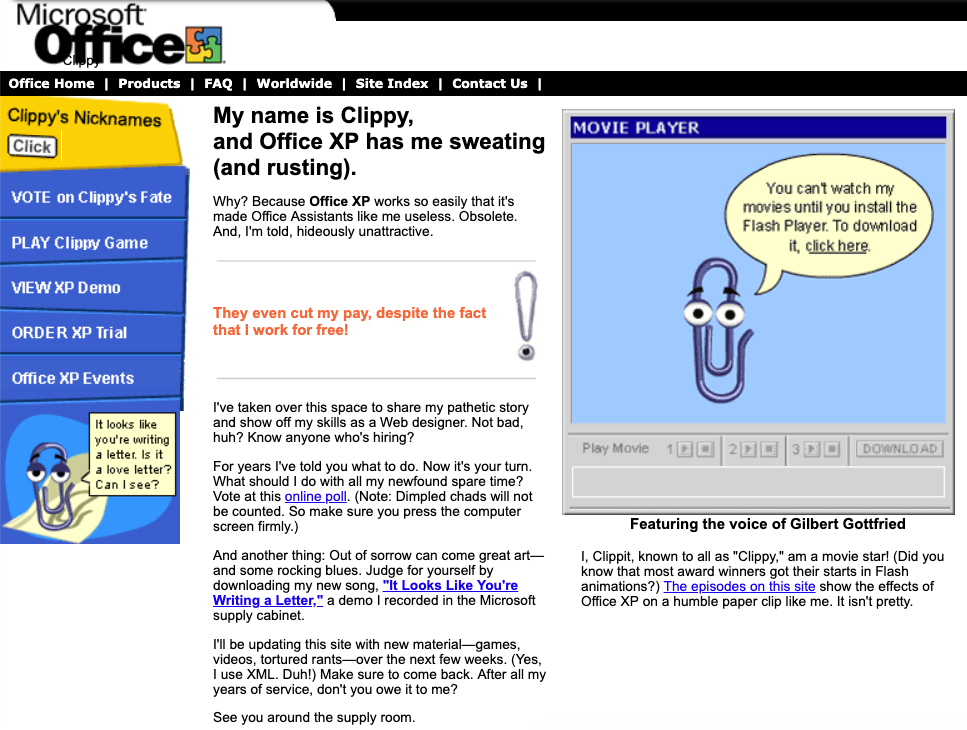It’s 2019, And Microsoft’s Clippy Is Still Popping Up In Deeply Weird Memes
Why does the world's most annoying paperclip refuse to die?

It’s the year 2019, we’re rapidly approaching the end of the second decade of the 21st century, and yet every couple of hours someone on this planet tweets about Microsoft’s Clippy.
The CGI paperclip is now 23 years old; older, perhaps, than many readers of this article. The virtual assistant hasn’t been enabled by default for close to 20 years, owing to the fact that it was a famously annoying, deeply reviled feature. It hovered, smug, in the corner of Microsoft Word documents, offering unsolicited input and taking up space.
“It looks like you’re writing a letter,” it would smirk. “Would you like help?”
I think I speak for most of us when I say that no, we never fucking wanted help, least of all from something posing as a sentient paperclip. And yet here we are, in a world where genuinely intelligent (and helpful!) AI actually exists, unable to stop thinking about Clippy.
Nostalgia comes for everything, apparently, including the world’s most annoying Office assistant. Earlier this year, a Microsoft employee’s Clippy-themed business cards went viral. A month later, some other Microsoft employees went rogue and briefly resurrected Clippy as part of a sticker pack available in Microsoft Teams. It was swiftly removed by the company’s “brand police”.
Ya girl got business cards ??☁️ pic.twitter.com/1nNBYvlZ1t
— Chloe Condon ? (@ChloeCondon) February 21, 2019
It’s not just Microsoft employees, either. Common Google searches featuring the word “clippy” in 2019 include “where did clippy go?”, “who killed clippy?”, and “can I get clippy back?”. There is, regrettably, Clippy fanfiction, Clippy erotica, and an entire bizarre saga involving fanart in which the paperclip is inexplicably pregnant. In slightly more mainstream territory, the release of Toy Story 4 and its beloved character Forky quickly led to comparisons with Clippy, the undisputed OG animated character composed of household junk.
Clippy walked so Forky could run. pic.twitter.com/qke7UM1u1p
— Surge (@PowahSurge) July 16, 2019
Clippy also crops up in more than a few memes, both as the hero (“It looks like you are trying to defend Brexit. Would you like to turn on Caps Lock and disable spell check?”), the villain (the ultimate mansplainer, duh), and, uh, this:
If you’re wondering how the hell we got here, you’re not alone. Here’s the story of how Clippy became (and remains) a literal icon.
Who Created Clippy? It’s Time You Met Microsoft Bob
The story of Clippy’s birth requires a brief detour into one of Microsoft’s even greater failures: Microsoft Bob.
There’s a good chance you’re too young to remember Bob. Back in 1995, Microsoft was brainstorming ways to help people learn to use a computer for the first time. Microsoft Bob was the result of an interesting brainwave: instead of showing users a desktop filled with icons, why not show them a room of a house, filled with familiar objects that symbolised the programs they might want to use?
Clicking on a calendar on the wall, for instance, would open the computer’s calendar. Clicking on the pen and paper on the living room table would open Microsoft Word. A cartoon dog (a predecessor to Clippy) would guide you around the house to find programs; instead of changing your desktop background, you could quite literally change the wallpaper (and/or style of your entire house, from “contemporary” to “postmodern” and more). It even came on a CD emblazoned with the Microsoft Bob logo, which looks a lot like today’s nerdy face emoji.

This is what Microsoft Bob looked like. You can see more pictures over here.
If all of this sounds wildly annoying, you’re spot on. Microsoft Bob was panned by critics, hated by users, and retired after just one year. Despite the program being geared towards new computer users, Melinda Gates has since acknowledged that Bob actually “needed a more powerful computer than most people had back then”.
And yet, Microsoft Bob’s legacy lives on. The need for a little character to lead users around the house led to the invention of Clippy. And, after typographer Vincent Connare noticed that the program’s fun cartoon characters were speaking to users via the inappropriately formal Times New Roman, Microsoft Bob led to the invention of Comic Sans. Yikes.

The fact that Clippy outlived Microsoft Bob is far from an accident. Clippy’s creator, Kevan Atteberry, was part of a team that designed close to 250 potential characters to guide users through Microsoft Office. Out of that field of 250, Clippy wasn’t just randomly selected to become the default: he was chosen after a rigorous, months-long process involving expert feedback, focus groups and more.
“Through working with some social psychologists out of Stanford, we spent six months going through them all, whittling them down with focus groups and stuff like that,” Atteberry told Vice a few years ago. “[Clippy] came out to be the number one most trustful and engaging and endearing character of them all. So he became the default.”
Oh, and Atteberry also said he designed Clippy on a Mac. Well played, Apple.
Why Was Clippy So Damn Annoying?
Given that focus groups described Clippy as “trustful”, “engaging” and “endearing”, it’s pretty spectacular how quickly things fell apart. People have written entire academic theses about why Clippy was so powerfully annoying, but it seems to boil down to the fact that he was continually interrupting you without saying anything useful at all.
In other words, Clippy was the ultimate mansplainer. And while it’s bizarre to gender an anthropomorphic paperclip, it turns out that users overwhelmingly do see Clippy as a man (Clippy’s creator included).
A quick poll of my colleagues revealed that the vast majority thought of Clippy as male. Roughly half of that group came to this conclusion based on the style of Clippy’s eyebrows, while the other half insisted that Clippy must be male given that he mansplains so much. While the former group perhaps needs to revisit their gendered view of eyebrows, the latter group has a good point.

The Junkee editorial team’s thoughts on Clippy’s gender.
All you had to do was type “dear” for Clippy inform you that “it looks like you’re writing a letter” and offer to help. Closing a document with even a single word in it prompted Clippy to leap up and ask if you wanted to save the changes you made.
Even trying to turn Clippy off prompted more smug commentary. “You’ve hidden me several times now,” he’d note. “Would you like to permanently turn me off or just hide me again?”. The automatically highlighted answer was ’no, just hide me’, because the idea that his input might not actually be wanted was beyond this goddamn paperclip’s comprehension.

And so, shortly after he was introduced, Clippy was sent the way of Microsoft Bob: to an early retirement. Microsoft actually used Clippy’s death as a marketing tool to promote Windows XP, launching a game where users could try to kill Clippy by flicking a rubber band at him. Copies of it still exist online, and it’s surprisingly difficult.
Yet unlike MS Bob, Clippy didn’t quite die. Actually, if anything Clippy’s seeing a bit of resurgence in popularity, thanks to memes.
Where Did Clippy Go?
Over his years in exile, something happened to Clippy. For many, he remains a distant memory, but for others, he’s become an object of increasing fondness. Personally, I think it’s because, literally and figuratively, Clippy is a particularly millennial icon.
With the benefit of hindsight, it’s possible to view Clippy very differently, and as much more than just an annoying paperclip. Before Siri, Cortana and Alexa ushered in a new era of disturbingly submissive, gendered virtual assistants, Clippy stood alone as a genderless, relentlessly annoying paperclip. Clippy was never here to serve users: Clippy put users in their fucking place.
The Siri of my generation.#clippy #Microsoft pic.twitter.com/lNl8bpWVBt
— Shko 3.2 (@shkoagha) July 22, 2019
i want a tattoo of clippy saying "just do better" pic.twitter.com/YolboLpqmZ
— elon musk's assistant (@jess_thxmas) July 22, 2019
This clippy also works for those defending Trump pic.twitter.com/JAGmLl9HRW
— Simen Sommerfeldt (@sisomm) July 19, 2019
In the world of 2019, where jaded distrust of AI and big tech is reaching a peak, the idea of a virtual assistant being deliberately obtuse is almost refreshing. It’s as though, by pissing off users, Clippy was a rogue employee giving the ultimate middle finger to his big tech overlords.
In fact, this reading of Clippy is backed up by the backstory Microsoft created to explain his retirement. When Clippy was fired, he responded in true millennial fashion: by setting up a website to talk shit about his former employer, and promote his side hustles in music, acting and web design.
The page was basically the 2001 equivalent of starting a passive-aggressive Patreon page after getting fired, and Clippy really didn’t hold back. “They even cut my pay, despite the fact that I work for free,” the irate paperclip complained. Go off, Clippy!

The website Clippy made shortly after being fired.
Clippy’s absolute failure to fulfil his one, extremely straightforward mission in life is deeply relatable. His being made redundant by big tech is deeply relatable. His never-ending stream of sassy commentary would fit right in on the Twitter feeds of today, and indeed, several people have created accounts on behalf of the paperclip.
It’s fitting, then, that Clippy is living on in memes. Long after actual physical paperclips are obsolete, I hope to see this one on my screens. Just not as a constant presence in the corner of every Word document. No one wants that.

